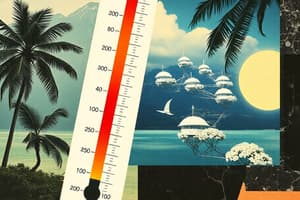Podcast
Questions and Answers
Explain why nights are generally cooler than days, referencing the role of insolation.
Explain why nights are generally cooler than days, referencing the role of insolation.
During the day, Earth receives insolation, which heats the surface. At night, insolation ceases, and Earth radiates heat into space, leading to a temperature decrease.
Describe how the angle of the sun's rays affects temperature, and provide an example using different latitudes.
Describe how the angle of the sun's rays affects temperature, and provide an example using different latitudes.
Direct rays concentrate solar energy over a smaller area, leading to higher temperatures. Slanting rays spread energy over a larger area, resulting in lower temperatures. The Equator receives more direct rays than higher latitudes.
How does the duration of sunlight impact seasonal temperature variations? Give examples for summer and winter.
How does the duration of sunlight impact seasonal temperature variations? Give examples for summer and winter.
Longer sunlight duration in summer allows for more insolation, resulting in warmer temperatures. Shorter sunlight duration in winter reduces insolation, resulting in colder temperatures.
Explain why the coldest time of night is usually shortly before sunrise.
Explain why the coldest time of night is usually shortly before sunrise.
Outline the key differences in the angle of incidence and daylight duration between the Northern and Southern Hemispheres during June and December.
Outline the key differences in the angle of incidence and daylight duration between the Northern and Southern Hemispheres during June and December.
Mention the factors that affect the temperature of a place.
Mention the factors that affect the temperature of a place.
Explain how coastal areas tend to have milder temperature fluctuations compared to inland areas.
Explain how coastal areas tend to have milder temperature fluctuations compared to inland areas.
How does altitude affect temperature, and why does this relationship exist?
How does altitude affect temperature, and why does this relationship exist?
Explain how slope of the land can affect temperature.
Explain how slope of the land can affect temperature.
Explain how ocean currents affect temperature.
Explain how ocean currents affect temperature.
Flashcards
Noon Temperature
Noon Temperature
Maximum angle of Sun's rays, heating a smaller area which results in high temperatures.
Evening Temperature
Evening Temperature
Sun's rays are slanting, causing temperature to decrease until sunset.
Night Temperature
Night Temperature
No incoming solar radiation, leading to continuous temperature decrease; coldest time is before sunrise.
Seasonal Temperature Changes
Seasonal Temperature Changes
Signup and view all the flashcards
Summer Temperatures
Summer Temperatures
Signup and view all the flashcards
Winter Temperatures
Winter Temperatures
Signup and view all the flashcards
Latitude and Temperature
Latitude and Temperature
Signup and view all the flashcards
Land and Sea Contrast
Land and Sea Contrast
Signup and view all the flashcards
Altitude and Temperature
Altitude and Temperature
Signup and view all the flashcards
Wind Direction
Wind Direction
Signup and view all the flashcards
Study Notes
-
At noon, the sun's rays are at a max angle of inclination
-
This covers a smaller area and the temperature is high
-
Increase in temperature is gradual, which is why the highest temperature is recorded
-
In the evening, the sun's rays become slanting again, so the temperature decreases
-
The temperature continues to decrease until sunset and through the night
-
At night, the part of the Earth experiences no incoming insolation, so the temperature decreases
-
The coldest part of the night is just before sunrise because a lot of heat has radiated out into space
-
This explains why nights are cooler than days
Seasonal Changes in Temp
-
The temperature of the atmosphere varies between day and night but also from season to season
-
This occurs because of the angle the sun's rays strike the Earth varies between seasons
-
In June, the sun's rays are more direct in the Northern Hemisphere
-
Days are longer in the Northern Hemisphere
-
This makes the duration of sunlight longer and consequently the amount of insolation received at any place higher in summer
-
In December the converse is true
-
In summer, more insolation reaches the Earth and the duration of sunlight is longer and summers are therefore hotter
-
In winter, the angle of incidence is lower, and the duration of sunlight is shorter, so winters are colder
-
Contrast in the angle of incidence during summer and winter at 50° N
-
On June 21, the sun shines for 16 hours 18 minutes
-
On December 22, the sun shines for 7 hours 42 minutes
Temperature Differences on the Earth
-
There are several factors that control the temperature of the atmosphere
-
Latitude is the spherical shape of the Earth causing different parts to be heated to different degrees
-
Regions near the Equator get more direct rays and are concentrated over a smaller area, heating the Earth more
-
As distance from the Equator increases, the sun's rays strike the Earth at an angle
-
The slanting rays spread the heat over a larger area, and do not heat to the same extent as direct rays
-
Temperature decreases as distance increases from the Equator
Factors Affecting Temp Of A Place
- Latitude: Distance from the Equator
- Distance from the sea: Land and Sea contrast
- Altitude: Height above sea level
- Slope of the land
- Wind direction
- Ocean currents
Studying That Suits You
Use AI to generate personalized quizzes and flashcards to suit your learning preferences.




